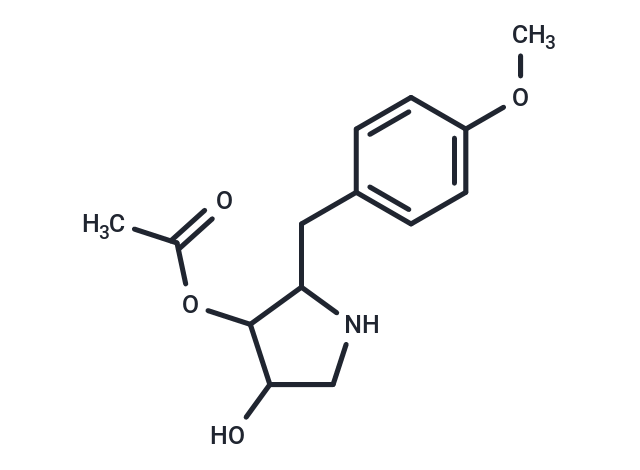Shopping Cart
Remove All Your shopping cart is currently empty
Your shopping cart is currently empty
Anisomycin is an antibiotic and protein synthesis inhibitor produced by Streptomyces griseolus. It is also a classic activator of p38 MAPK and JNK. By inhibiting protein synthesis, anisomycin induces cellular stress, which activates upstream kinases and subsequently leads to the phosphorylation and activation of p38 MAPK and JNK.

| Pack Size | Price | USA Warehouse | Global Warehouse | Quantity |
|---|---|---|---|---|
| 5 mg | $34 | In Stock | In Stock | |
| 10 mg | $46 | In Stock | In Stock | |
| 25 mg | $63 | In Stock | In Stock | |
| 50 mg | $90 | In Stock | In Stock | |
| 100 mg | $161 | In Stock | In Stock | |
| 500 mg | $377 | In Stock | In Stock | |
| 1 mL x 10 mM (in DMSO) | $50 | In Stock | In Stock |
| Description | Anisomycin is an antibiotic and protein synthesis inhibitor produced by Streptomyces griseolus. It is also a classic activator of p38 MAPK and JNK. By inhibiting protein synthesis, anisomycin induces cellular stress, which activates upstream kinases and subsequently leads to the phosphorylation and activation of p38 MAPK and JNK. |
| Targets&IC50 | U251 cells growth:0.233 ± 0.021 μM, peripheral lymphocytes:25.44 ng/mL, U-87MG cells growth:0.192 ± 0.018 μM |
| In vitro | Anisomycin (3 μM) decreases protein synthesis in MDA16 and MDA-MB-468 cells, and reduces colony formation by MDA-MB-468 cells. Anisomycin causes an increase in the number of apoptotic cells in MDA-MB-468 cultures, but not in MDA16 cultures. Anisomycin actives JNK phosphorylation in MDA-MB-468 cells.[2] In U251 and U87 cells, anisomycin?(0.01-8 μM) inhibits the cell growth in time- and concentration-dependent manners with the IC50 (48 h) values of 0.233 and 0.192 μmol/L, respectively. Anisomycin?(4 μM) causes 21.5% and 25.3% of apoptosis proportion in U251 and U87 cells, respectively, and activates p38 MAPK and?JNK, while inactivated ERK1/2. Anisomycin?(4 μM) reduces the level of PP2A/C subunit in a time-dependent manner in U251 and U87 cells.[3] Anisomycin inhibits EAC cell proliferation in concentration-dependent manner.[4] |
| In vivo | Peritumoral administration of anisomycin (5 mg/kg) significantly suppresses Ehrlich ascites carcinoma (EAC) growth resulting in the survival of approximately 60% of the mice 90 days after EAC inoculation.[4] |
| Kinase Assay | JNK phosphorylation: 500,000 cells/well are seeded in 6-well plates and incubated overnight. Cells are then incubated for 1 h with test compounds or DMSO as vehicle control (?nal concentration 1% v/v). Puromycin is added (?nal concentration of 18 μM) and cells incubated for a further 10 min to label nascent polypeptide chains. Background labelling is determined by incubating cells without puromycin. Cells are then washed in HBSS, harvested by scraping and centrifuged (300 g, 5 min). Cells are resuspended in 0.5 mL 50 mM DTT containing phosphatase inhibitors and incubated at 95℃ for 10 min. Samples are then snap frozen in liquid nitrogen and stored at -20℃ until blotted. Samples (20–30 μg protein/sample) are blotted onto a PVDF membrane. The membrane is blocked and incubated with anti-phospho-Thr183/Tyr185-JNK antibody overnight at 4℃. Secondary antibodies are used to label the primary antibody and detected using an infrared scanner. The intensity of the ?uorescence signal for anti-phospho-JNK antibody is background corrected and normalized for loading. |
| Cell Research | For the assay, EAC cells are plated in 96-well plates at a density of 10,000 cells/well/200 μL of medium. The cells are treated with the different concentrations of anisomycin for 48 h. Adriamycin (500 ng/mL) is used as a positive control. 0.5 mg/mL of MTT is added to each well. 4 h later, the formazan product of MTT reduction is dissolved in DMSO, and absorbance is measured at 570 nm using a Model 680 microplate reader.(Only for Reference) |
| Synonyms | Wuningmeisu C, NSC 76712, Flagecidin |
| Molecular Weight | 265.3 |
| Formula | C14H19NO4 |
| Cas No. | 22862-76-6 |
| Smiles | COc1ccc(CC2NCC(O)C2OC(C)=O)cc1 |
| Relative Density. | 1.21 g/cm3 |
| Storage | Powder: -20°C for 3 years | In solvent: -80°C for 1 year | Shipping with blue ice/Shipping at ambient temperature. | ||||||||||||||||||||||||||||||||||||||||
| Solubility Information | Ethanol: 13.3 mg/mL (50.13 mM), Sonication is recommended. DMSO: 118.75 mg/mL (447.61 mM), Sonication is recommended. | ||||||||||||||||||||||||||||||||||||||||
| In Vivo Formulation | 10% DMSO+90% Saline: 2.66 mg/mL (10.03 mM), Solution. PBS: 2.5 mg/mL (9.42 mM), Sonication is recommended. Please add the solvents sequentially, clarifying the solution as much as possible before adding the next one. Dissolve by heating and/or sonication if necessary. Working solution is recommended to be prepared and used immediately. The formulation provided above is for reference purposes only. In vivo formulations may vary and should be modified based on specific experimental conditions. | ||||||||||||||||||||||||||||||||||||||||
Solution Preparation Table | |||||||||||||||||||||||||||||||||||||||||
Ethanol/DMSO
DMSO
| |||||||||||||||||||||||||||||||||||||||||
| Size | Quantity | Unit Price | Amount | Operation |
|---|

Copyright © 2015-2025 TargetMol Chemicals Inc. All Rights Reserved.